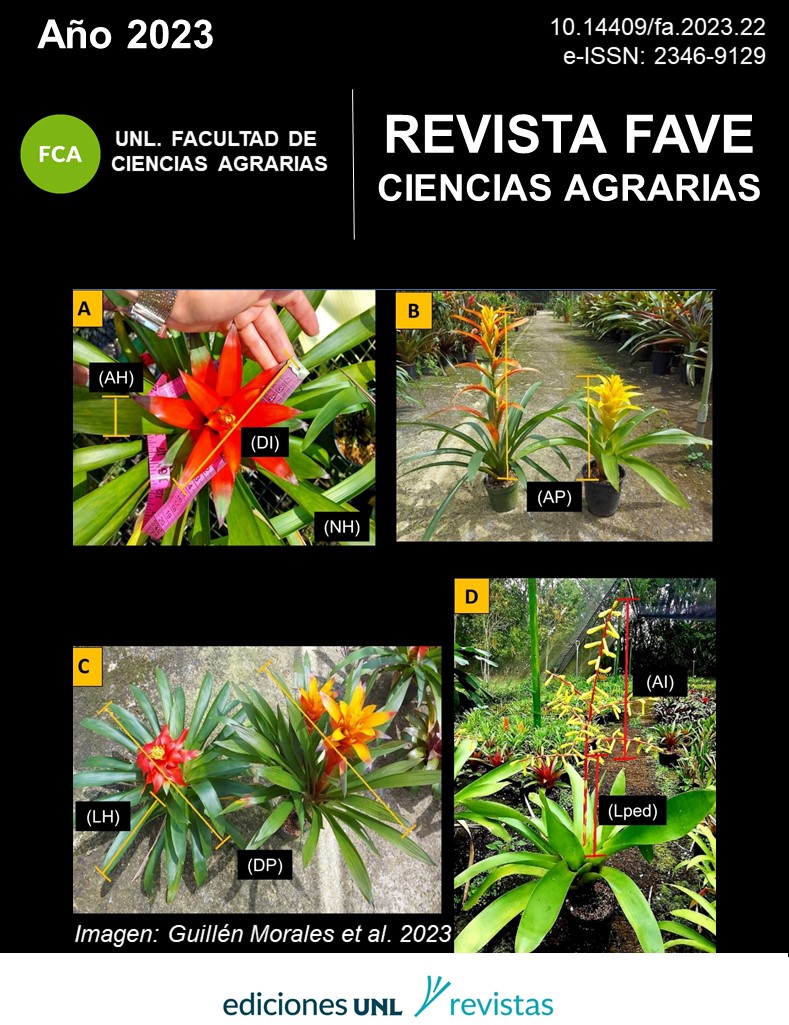Morphological characterization and genetic variability in genotypes of the genera Vriesea and Guzmania (Bromeliaceae) with ornamental potential
DOI:
https://doi.org/10.14409/fa.2023.22.e0006Keywords:
bromeliads, variability, selection, plant breeding, germplasmAbstract
Bromeliads have a high commercial potential as ornamental species. The creation of new varieties is of utmost importance for the market. The objective of this research was to evaluate the morpho-agronomic variability of hybrids from intra and interspecific crosses of Guzmania lingulata, G. freya, G. wittmackii, G. conifera, G. zahnii and the Vriesea “Electric” cultivar. Ten groups of plants from crosses between accessions of Guzmania and Vriesea were studied for a commercial exploitation of bromeliads between 2017 and 2018, to which the quantitative variables were measured: plant height, plant diameter, peduncle length, number of leaves, length of leaves, width of basal leaves, length of inflorescence and diameter of inflorescence. Descriptive statistics were determined for these variables as mean, CV and SD and an ANOVA was performed with a Duncan mean separation test at 0,05%. The variables were subjected to an analysis of principal components and Pearson's correlations. Regarding results, it was obtained that crossing 1 reached the highest values for all the variables except NH and DI, while crossings 4 and 6 showed the lowest values for most of the variables (p<0,05). Highly correlated variables were found, such as peduncle length (Lped) and plant height (AP), peduncle length (Lped) and plant diameter (DP), leaf length (LH) and plant diameter (DP). and inflorescence height (AI) with plant height (AP). In general, in the principal components analysis, it was found that all the variables, except the Inflorescence Diameter (DI), contribute to the variability in the first two components. According to the analyzes carried out and the quantified variables, sufficient variability was found to develop a plant breeding program.
References
Azimi, M.H., & Alavijeh, M.K. (2020). Morphological traits and genetic parameters of Hippeastrum hybridum. Ornamental Horticulture, 26(4): 579-590. https://doi.org/10.1590/2447-536X.v26i3.2153
Balzarini, M.G., Gonzalez, L., Tablada, M., Casanoves, F., Di Rienzo, J.A., & Robledo C.W. (2008). Manual del Usuario Infostat. Córdoba, Argentina. Ed. Brujas.
Bhajantri, B., & Patil, V.S. (2016). Genetic diversity analysis in Gladiolus Genotypes (Gladiolus hybridus Hort). Journal of Applied and Natural Science, 8(3): 1416-1420. https://doi.org/10.31018/jans.v8i3.975
Brenes, P. (2019). Jardín Botánico del CATIE inaugura el primer jardín de bromelias rescatadas de Costa Rica. [Online]. Disponible en: https://www.catie.ac.cr/catie-noticias/3798-jardin-botanico-del-catie-inaugura-el-primer-jardin-de-bromelias-rescatadas-de-costa-rica.html
Chacón, K., & Monge, J. (2020). Cucumber (Cucumis sativus L.) production under greenhouse conditions: correlations among variables. Revista Posgrado y Sociedad, 18 (2): 53-70.
Camarena, F., Chura, J., & Blas, R.U. (2008). Mejoramiento genético y biotecnológico de plantas. UNALM. Press.
Ceballos, H. (2003). Genética cuantitativa y fitomejoramiento. Universidad Nacional de Colombia. UNAL Ed.
Climate-Data. (2021). Clima de Palmares [Online]. Disponible en: https://es.climate-data.org/america-del-norte/costa-rica/san-jose/palmares-642974/#climate-table
Espitia, M., Vallejo, A., & Baena, D. (2005). Correlaciones fenotípicas, genéticas y ambientales en Cucurbita moschata Duch. Ex Poir. Ciencias agropecuarias y biológicas, 11 (2): 131-140.
Farias, M., Peternelli, L.A., & Pereira, M.H. (2013). Classification of the coefficients of variation for sugarcane crops. Cienc. Rural, 43(6): 957-961.
Gallego, L., & Araque, O. (2019). Variables de Influencia en la Capacidad de Aprendizaje. Un Análisis por Conglomerados y Componentes Principales. Información tecnológica, 30(2): 257-264. http://dx.doi.org/10.4067/S0718-07642019000200257
Hernández, A. (2013). Caracterización morfológica de recursos fitogenéticos. Revista Bio Ciencias, 2(3): 113-118.
Hernández, E., Rangel, S., López, M., & Guerrero, A. (2018). Germinación, viabilidad, y regeneración in vitro de plantas de Vriesea heliconioides (Kunth) Hook. Ex Walp. Revista Fitotecnia Mexicana, 41(2): 99-106. https://doi.org/10.35196/rfm.2018.2.99-106
Lobo, I., & Shaw, K. (2008). Discovery and Types of Genetic Linkage. Nature Education, 1(1): 139
Manfio, C.E., Yoshimitsu, M.S., Coelho de Paula, C., Sávio, M., & Gamarano, M.C. (2010). Early selection of elite clones of an ornamental bromeliad in vitro. Ciência Rural, 40(7): 1537-1544.
Miranda, M.E., Arellano, J.J., Salazar, B.Z., Hernández, F., Quero, R., & Pérez, L. (2007). Bases para el manejo comunitario de Bromelias Ornamentales. Colección Manejo Campesino de Recursos Naturales y Red de Aprendizaje Intercambio y la Sistematización de Experiencias hacia la Sustentabilidad (RAISES). Oaxaca, México.
Mondragón, D., Ramírez, I., Flores, M., & García, J. (2011). La familia Bromeliaceae en México. [Online]. Disponible en: https://www.gob.mx/cms/uploads/attachment/file/225103/La_familia_bromeliaceae_en_mexico.pdf
Nakayama, H.D., González, M.C., Samudio, A., Britos, R.M., Mussi, C., Cantero, F.A., Benítez, J.V., & Peralta, I. (2018). Fitomejoramiento participativo del Ka´a He´e. Consejo Nacional de Ciencia y Tecnología (CONACYT) [Online]. Disponible en: https://www.conacyt.gov.py/sites/default/files/upload_editores/u454/Manual-Fitomejoramiento.pdf
Neri, J., Wendt, T., & Palma-Silva, C. (2017). Natural hybridization and genetic and morphological variation between two epiphytic bromeliads. AoB Plants, 10(1): plx061. https://doi.org/10.1093/aobpla/plx061
Neves, B., Zanella, C.M., Kessous, I.M., et al. (2020). Drivers of bromeliad leaf and floral bract variation across a latitudinal gradient in the Atlantic Forest. J. Biogeogr., 47(1): 261-274. https://doi.org/10.1111/jbi.13746
Nieto, D. (2017). Inducción de variabilidad en aguacate cv Hass mediante mutagénesis radioinducida. [Tesis de Maestría, Universidad Autónoma del Estado de México]. Repositorio Institucional:http://ri.uaemex.mx/bitstream/handle/20.500.11799/69131/TESIS%20DANIEL%20NIETO.pdf?sequence=2&isAllowed=y
Pragya, R., Bhat, K.V., Misra, R.L., & Ranjan, J.K. (2010). Analysis of diversity and relationships among Gladiolus cultivars using morphological and RAPD markers. Indian Journal of Agricultural Sciences, 80(9): 766- 772
Ramírez, G., & Chávez, L. (2015). Mejoramiento genético de ornamentales del Estado de México. Instituto de investigación y capacitación Agropecuaria, Acuícola y Forestal del Estado de México- ICAMEX. Ed. Grupo Produce.
Sharma, S., Dastagiri, M.B. & Reddy, N. (2017). Morphological Variation and Evaluation of Gladiolus (Gladiolus x hybridus Hort.) cultivars. J. Hortic, 4(4): 16-26. https://doi.org/10.4172/2376-0354.1000212
Solís-Ramos, L, & Andrade, A. (2005). ¿Qué son los marcadores moleculares? Rev. Divulg. Cientif. Tecn. Univ. Veracruz. [Online]. Disponible en: https://www.uv.mx/cienciahombre/revistae/vol18num1/articulos/moleculares/index.htm#:~:text=Estos%20marcadores%20tienen%20la%20ventaja,utiliza%20peque%C3%B1as%20cantidades%20de%20material.
Vieira, S.D., Rabbani, A.R.C, Santos, F., Silva-Mann, R., Arrigoni-Blank, M.F., Prata, A.P.N., Resende, L.V., Pasqual, M., & Blank, A.F. 2014. Molecular characterization of bromeliads from northeast Brazil. Genet. Mol. Res., 13(4): 9851-9860.
Zucchi. M.R., da Silva, M.W., Sibov, S.T., & Pires, L.L. (2019). Ornamental and landscape potential of a bromeliad native to the Cerrado. Ornamental Horticulture, 25(4): 425-433. https://doi.org/10.1590/2447-536X.v25i4.2003
Zuñiga, A., & Carrodeguas, A. (2022). Variabilidad morfo-agronómica en genotipos de arroz en el Pacífico Central, Costa Rica. Revista Ciencia y Agricultura, 19(1): 1-14. https://doi.org/10.19053/01228420.v19.n1.2022.12567

















